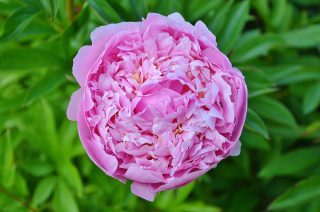Saffron is harvested from the flowers of Crocus sativus (Iridaceae), known as the saffron bulb. Propagated by bulbs called “corms” where each corm forms new bulbs, and this is how the plant reproduces. The saffron flowers bloom in autumn and are harvested for the red pistils that we all know as “saffron pistils”, from which the spice is extracted. Each bud produces three stigmas, which are picked by hand carefully. The flowers are harvested by noon, because they easily wither. E` a laborious process and requires great attention, which is why saffron has become so precious to be called “red gold”.
Terrain
Crocus sativus bulbs adapt to the soil in which they are planted deep. They grow well on arid or semi-arid soils. The bulbs adapt well to the calcareous soil, which is neutral clay with a pH of 6 to 8. They grow well also on ferruginous, sedimentary and sandy soils enriched with organic material.
What is really important is that the soil allows the roots to make their way deep and that it is well drained to prevent the bulbs from rotting or becoming infected.
Climate
Saffron needs summer and winter climatology with summer temperatures from 35 C to 40 C and about -15 C or -20 C in winter. For this reason saffron can be cultivated in dry, moderate and continental but not polar or tropical climate types.
If extreme frost “threatens” the saffron field, it is advisable to cover the plants with straw or fiber tissue to protect them, until the frost comes off. Rains are considered good for the development of bulbs in fact this means a higher production of bulbs of daughters and flowers; during the dry spring irrigation is essential.
Sowing
For the sowing it is good to choose virgin land plots where no other tuber and saffron bulb has ever been planted before, otherwise at least not in the last ten years.
Recommended plowing the soil with a depth ranging from 20 to 50 cm, this allows you to keep free and well ventilated seed beds.
It is ideal to ensure irrigation and drainage the planting of bulbs on raised beds. Once the leaves of the bulbs have sprouted, irrigation must be minimal.
In the months of August and September the sowing is done both by hand and by machine, while for the harvest are about eight weeks after the sowing, from late October to mid-November.
Sun lovers, crosses should be planted in open and dry soil rather than in the shade.
Usually, the bulbs are planted at a depth of 7-15 cm. The deeper they are planted, the less they multiply, the less abundant the harvest, but the higher the quality of the flowers produced.
When planting saffron bulbs, the “file system” is used. Each row is 15-20 cm from the other
Spacing also depends on how often you dig up. The digging up consists in the complete extraction of the bulbs from the soil to separate the mother bulbs from the children bulbs that have formed and to keep them for the next season of sowing. The biennial unearthing requires a spacing between the bulbs between 5 and 10 centimeters; for a longer period, it calculates 10-20 centimeters.
Pesticides
During the cultivation of saffron, protective measures must be taken against birds, rodents and rabbits. Bulb rot, plant rust and other pathogens must be prevented from damaging crocus plants.
Unearthing
The saffron bulbs continue to be suitable for cultivation for four years, then, at the fourth, they must be unearthed. The fields are overturned using a mechanical hoe or plough and the bulbs are harvested by hand. They are then cleaned of weeds and unusable bulbs. The bulbs do not have to stay out in the sun for more than two hours, then the grouped bulbs are stored in a place away from light, dry but well ventilated, until the next season of sowing.
Weeding
To tear the weeds you have to use the tedious manual method, especially in case of rooted weeds. Mechanical weeding can be used in the cultivation of saffron, but there is a risk of damaging the bulbs. Thus, many farmers prefer to do so in the traditional way. The longer the weeds stay in the soil where the saffron plants grow, the harder it will be to remove them, so it is better to take care of them as soon as possible. When the saffron leaves are wilted, but it is not yet time to dig up, the brown leaves are removed to easily spot the weeds.
Drying
Immediately after the withering, it is dried, also called roasting, which is done daily until the last pistils are dry. Because they are too humid, the collected stigmas are dried by roasting at a temperature no higher than 60 º C. You must be very careful so that the pistils do not cook too much. Therefore the “roaster” (the person assigned the task) plays a very delicate role in the production of quality saffron. After roasting, the pistils will have greatly reduced size and weight, up to 80% of the original ones. You need five kilos of fresh stigma to get a single kilo of dry pistils, a vivid red color.
The stigmas can also be dried on coals or in an oven. For the drying of large quantities, saffron pistils are placed in a special room at a temperature of 30 C-35 C-C for 10-12 hours. A more modern method consists in the use of a dehydrator, aimed at 49 C, for 3 hours. It seems that the time required depends on the amount of pistils to be dried. But the important thing is that they are not dried too much, because this would mean a reduction in the quality and price of saffron pistils.
Conservation
When the pistils are dry, they get a vivid red color, which fades into dark orange at the tips. They are cooled and wrapped in fabrics or aluminium foil and placed in hermetically sealed jars, covered and kept in a secluded place for at least thirty days before they are ready for use. They can stay in that corner for a year and still be able to flavor the food.
Vegetable cycle in the cultivation of saffron
Saffron bulbs pass through active, transient and dormant phases. The active period begins when they are planted and develop roots, buds, leaves and flowers. The transitional period is when the bulbs become mother bulbs and produce new bulbs, or offspring bulbs. The dormant period is when the bulbs reach the mature phase and no longer produce bulbs. The dormant period is characterized by withered leaves and dried up roots. To be productive again, saffron bulbs should be removed from the ground and set aside for a while before being replanted.
As for the sowing area, it would be ideal to allow a saffron field to “rest” for at least ten to twelve years after a cycle of cultivation has been exploited to the maximum, so that the land can recover and become fertile again. To start a new cycle it is better to move to a virgin field. This will ensure you a durable plantation, which will give you good production for another period.
Bulb size
The bulbs are classified according to their size, in fact, the larger the mother bulbs, the more children they produce, the more abundant is the production of flowers and stigmas. The regeneration of saffron bulbs is significantly reduced over the years and for a cultivation of saffron over many years, it is necessary to plant the smaller bulbs in virgin fields, so that they can increase in size.




